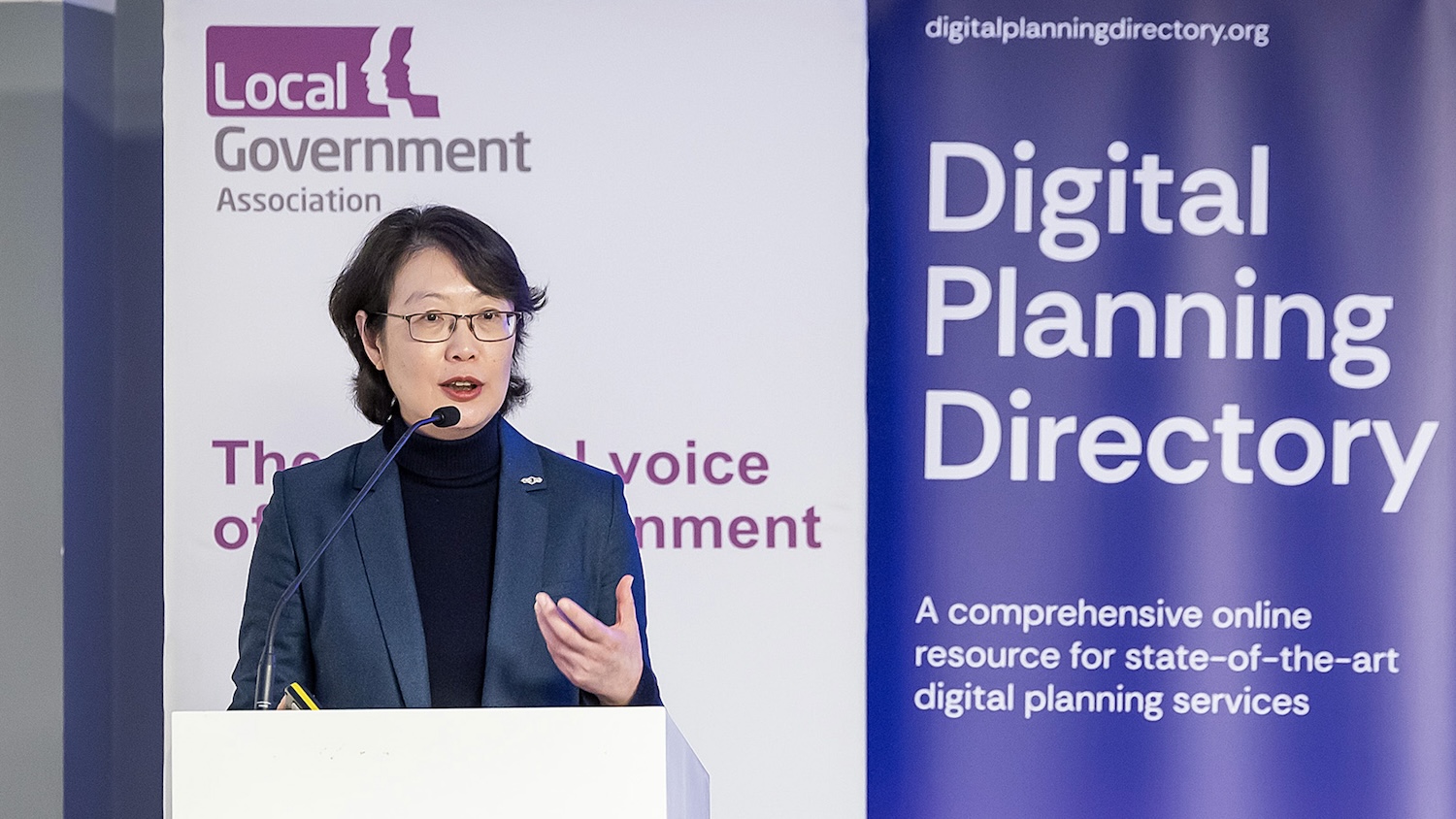
Digital planning can revolutionise the way we plan, design and manage cities and towns to help make them greener and more socially equitable, says Dr Wei Yang, a visionary planner and a driving force towards making it happen.
Dr Wei Yang’s CV is a testament to the idiom if you want something doing, ask a busy person. Her day job is chair of the planning consultancy she founded, Wei Yang & Partners, where she advises on implementing largescale regeneration and low-carbon masterplanning projects in Britain and internationally.
She’s also a member of the New Towns Taskforce, chair of the Construction Industry Council, a past president of the Royal Town Planning Institute (RTPI) in 2021, an author and honorary professor at the Bartlett Centre for Advanced Spatial Analysis, University College London. There are other additional roles on that CV, too numerous to list here. She was awarded an OBE in 2022 for services to planning.
We meet over Teams to talk about her hugely ambitious mission to digitalise spatial planning methods and planning processes as CEO of the UK’s Digital Task Force for Planning, a not-for-profit social enterprise. She was its co-founder with Professor Michael Batty, Bartlett Professor of Planning at University College London, in February 2021.
The organisation’s remit is simple in principle, but hugely challenging in practice: “To promote digital integration and advancement in spatial planning to tackle the grand challenges of the 21st century.” Climate change is not the least of those challenges.
A blueprint for the digital transformation the Task Force is aiming for was set out in February 2022 in A Digital Future for Planning – Spatial Planning Reimagined, which she co-authored.
So, what are the steps the planning profession must take on this journey and just how can the barriers to create a more efficient and forward-thinking planning landscape be broken down?
BIMplus: How did the Digital Planning Task Force come about?
Dr Wei Yang: The Task Force grew from my work on the 21st Century Garden Cities model, which explores how we can apply the original Garden City principles using modern technology. [She is a co-author of the book Humanistic Pure Land and Garden Cities – ed.]
I’ve felt for some time that urban planning hasn’t fully benefited from advancements in digital technology, and that we need a transformative approach to address today’s grand challenges – climate change, social inequality and public health.
When I ran for the RTPI presidency, I campaigned on the idea of modernising the planning profession. After being elected, I followed through by forming the Digital Task Force for Planning, with Professor Michael Batty. Our initial goal was to raise awareness about the urgent need for digital planning and to explore its potential impact.
We set it up to be completely independent, so the research question is defined by us – what can be done to make our world a better place?
The Ministry of Housing, Communities, and Local Government has been very supportive. In May last year, we signed a memorandum of understanding to collaborate on advancing digital planning. They provided seed funding for one of our first projects – the Digital Planning Directory, which launched in January.
What is the Digital Planning Directory?
Is planning education keeping pace with digital transformation?
There has definitely been progress in incorporating digital tools into planning education. Many universities now use tools like GIS and digital modelling software, which is great for helping students understand spatial planning in a digital context. However, the industry is evolving so quickly that universities can’t always keep up with the latest developments.
Planners are good at using software developed for them, but the real challenge is understanding the methodologies behind these tools and knowing what questions to ask. For example, planners still rely heavily on PDFs for planning applications. While PDFs serve a purpose, they’re not ideal for data accessibility or future use. Moving away from such static systems will open up new possibilities for more interactive, data-driven planning processes.
It’s essentially a one-stop shop for state-of-the-art digital planning solutions. It lists digital service providers in the UK, and we have big plans to expand it.
We aim to develop a digital planning education and training listing, as well as a procurement resource hub to help organisations navigate the requirements of digital planning. The idea is to bridge the gap between digital technology and mainstream planning practice – helping planners understand what’s possible and supporting companies in bringing their innovations to market. The launch of the Directory has been regarded as a milestone moment for the UK’s planning sector.
What kind of companies are listed in the directory?
We have more than 100 companies so far, ranging from startups to large international firms. Some focus on GIS mapping, digital twins or environmental analysis, while others are software developers or planning consultancies that have created their own digital tools. The key requirement is that they must provide evidence of innovative digital solutions.
The procurement resource hub… what’s the challenge there?
Procurement can be a major barrier, especially for smaller companies trying to work with local authorities. Many planning departments don’t know how to procure digital services effectively, and many innovative companies struggle to navigate public sector procurement rules. The hub will offer guidance on how to prepare proposals, meet procurement requirements and make the business case for digital solutions.
Why is the Task Force structured as a social enterprise?
Digital technology is often used in the private sector to maximise profits, but our mission is different. We exist to serve the public interest. By operating as a social enterprise, we ensure that our work remains focused on societal benefits rather than commercial gain.
I often describe the Task Force as a digital National Trust that preserves knowledge as an asset for the public good. I believe that, in the future, the most valuable assets will not only be property and land, but also data and the ability to analyse it in the public interest.
How will digital skills evolve in the planning profession?
Digital training wasn’t traditionally part of a planner’s education, so many professionals find it overwhelming. But it’s not about learning to code, it’s about understanding what’s possible and asking the right questions. We need to bridge the gap between planners and tech specialists. The future of planning will inevitably be digital, so helping professionals acquire these skills is crucial.
Local councils need to focus on growing their teams of digital experts and laying a solid foundation for digital transformation. A concerted effort from both local and national governments is necessary to ensure the digital infrastructure is in place.
The Digital Task Force for Planning can also play a pivotal role by acting as a critical friend to help councils move forward with their digitalisation efforts.
Is the cost of digital technologies a barrier for local authorities?
It’s a bit of a chicken-and-egg situation. While the upfront cost of digital transformation can be significant, the long-term savings are immense. By digitising planning processes, councils can reduce inefficiencies and duplication.
Many departments work in silos, and information isn’t shared across them, which leads to wasted resources. If we can break down these silos and share data more effectively, we’ll see cost savings and a more efficient planning system. It’s about altering the way we work, not just introducing new technology.
What is next for the Task Force?
We’re planning more showcase events and working on funding to develop the common spatial data environment. Our mission is to transform spatial planning methodology, ensuring decisions are made based on future trends and multi-faceted evidence, not just historical data. Crucially, a feedback loop is needed to ensure we can gather real evidence quickly enough to enable an agile approach to planning.
Right now, every council sources its own data separately, and there’s no standardised national platform for planning use. We want to create a common spatial data environment where all essential planning-related data – mapping, environmental constraints, infrastructure provisions, socio-economic factors, and anonymised public health data – can be accessed in one place. This would save local authorities significant resources and improve consistency in planning decisions, as well as make strategic planning possible.
Are there any councils already ahead in digital planning?
The Greater London Authority, the City of London Corporation and the Greater Cambridge Shared Planning Service are strong examples. Places like Newcastle, Nottingham and Plymouth are also making great strides in integrating digital tools into their planning processes.
Will we see significant change within the next five years?
Change needs to happen quickly. The pace of technological advancement, particularly in AI and data usage, is accelerating. If we don’t embrace these changes soon, we risk falling behind technology developed for profit-driven purposes or simply digitising the current imperfect linear system without fully benefiting from the full potential of digital transformation.
The technological methods and many datasets are already available: what’s needed now is a shift in mindset and a concerted effort to implement these changes across the industry.
The effective utilisation of digital tools and data can help bring evidence to the forefront, making it easier for both the public and professionals to understand how places are used and how they can be improved. This evidence-based systems approach will drive more effective planning and ultimately create better communities.
Don’t miss out on BIM, information management and digital construction news: sign up to receive the BIMplus newsletter.












